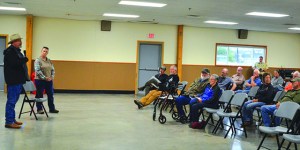Out and About: Summits and snowshoes
Published 5:00 am Sunday, January 28, 2024

- Jacoby
Went to the woods last weekend to see what changes a couple weeks of wintry weather had wrought.
Trending
Quite a lot.
Although I didn’t need to look around at the snow-draped trees to gauge the differences.
The sweat trickling down my back supplied plenty of tangible, and unpleasantly clammy, proof.
Trending
The skimpy snowpack from the first week of 2024 had swelled.
And with little time for the fresh snow to consolidate, our snowshoes, which can tussle with but never truly conquer physics, sank deeply with each stride.
Snowshoeing, the most sluggish sort of winter travel aside from a snowmobile stuck in a drift, requires a certain adjustment in perspective.
Also a lot of heavy breathing.
When you’re getting around on snowshoes, and especially in the soft stuff, a mile is a considerable distance.
Once you’re accustomed to the placid pace, though, the tortoise-like progress is not without its attractions.
Hares, for instance.
Although we didn’t see any of the aptly named snowshoe hares during either of our hikes, on Jan. 20 and 21, at our modest speed we could hardly miss the multitude of the animal’s distinctive tracks.
(The pattern is two prints in the front, one directly in front of the other, with the rear pair side by side.)
My wife, Lisa, and I saw hare tracks both on Jan. 20, when we walked near Catherine Creek Summit southeast of Union, and the next day at Tipton Summit southwest of Baker City, where we were joined by our son, Max, who’s 12.
I picked the places for a couple reasons.
First, both are along well-maintained highways so it was unlikely I would get our rig stuck and end up straining my back and my flair for inventive profanity.
Second, I like summits.
More specifically, I like divides — the spines of high ground between rivers.
Catherine Creek Summit, the high point on Highway 203 between Medical Springs and Union, separates Catherine Creek to the north and the Powder River drainage to the south.
Tipton, along Highway 7 between Sumpter Valley and Austin Junction, is a triple divide — one natural, two manmade.
The natural division is between the Powder River to the north and the Burnt River to the south.
The summit is also the place where two counties, Baker and Grant, and two national forests, the Wallowa-Whitman and the Malheur, come together.
Another advantage of divides is that, being elevated, they typically yield vistas.
But not when clouds hang low.
All the way to the ground, in fact, during our trip to Tipton, where fog obscured the Greenhorn and Elkhorn mountains but also much smaller and nearer objects, such as ponderosa pine trees.
The stratus layer was somewhat higher the previous day at Catherine Creek. Our route, though, was mainly in the timber, so the only distant view of note was a swatch of the ridge south of China Cap peak.
But of course it was clouds — and the tendency of mountains to wring moisture from those clouds — that ensured we slogged through snow rather than clanged our plastic snowshoes off barely submerged stones and logs.
Which was what happened in December when Lisa and I snowshoed near Deer Creek, on the west side of the Elkhorns.
Catherine Creek
The sno-park just west of Highway 203 at the 4,158-foot summit makes for easy parking, a welcome attribute in mid-winter. There’s even an outhouse.
You will need an Oregon Sno-Park permit, however.
The sno-park is particularly popular with snowmobilers.
On Jan. 20 there were a few dozen pickup trucks, most hauling snowmobile trailers, parked in the lot, parts of which were paved last year.
Forest Road 77, which starts on the east side of the highway, is a snowmobile thoroughfare, a groomed route that leads to West Eagle Meadows, Taylor Green, Boulder Park and Eagle Creek among other destinations in the Wallowa Mountains.
There is a network of trails, generally not plied by snowmobiles, in the forest to the west of the parking lot, but we hiked Road 950, which heads north from the 77 Road a couple hundred feet east of the highway.
Road 950 is mostly flat. It follows the lay of the land on the north side of the divide, above the canyon carved by Scout Creek, a tributary to Catherine Creek.
The road continues for a few miles and connects to other roads, some of which lead to Road 77.
Another attraction at the summit is an unofficial sledding hill on the east side of the highway just north of the sno-park. Road 950 is the top of this hill.
On our way back we met a woman and two girls sledding. They had rigged up a homemade rope tow, powered by a handheld cordless drill drive. I dearly wanted to see this device in action but the woman said the spindle attached to the spool of nylon rope needed repairs.
It was a clever idea, and one Lisa and the woman both said they had seen on social media.
Tipton Summit
I hadn’t noticed, despite my affinity for maps, that this highway pass is almost exactly 1,000 feet higher than Catherine Creek — 5,124 feet.
The difference in elevation was reflected in the snow depth.
There was, I judged, about 3 feet.
(An automated snow-measuring station nearby put the figure at 33 inches, and seeing as that’s derived by means of a laser, which is capable of a precision my astigmatic eyes can’t match, I suppose I should go with 33 inches.)
Anyway the snow was deep — close to twice as deep as at Catherine Creek.
But the snow at Tipton was a bit more firm.
Our snowshoes still sunk in several inches, but we walked for a while on a groomed snowmobile trail — Forest Road 2620 — and the powder there lay atop a firm base.
As at Catherine Creek, there is a dense network of roads on both sides of Highway 7 at Tipton Summit.
On the way back to the highway we struck off through the trees, hoping to spot one of the snowshoe hares that had, based on the volume of tracks, been quite busy.
Despite the fog it was a pleasant day, with a temperature around freezing and only the barest breath of wind — always a reason to celebrate, so rare are calm days in winter.
We didn’t see any hares but we found a burrow in a snow-covered stump where, based on the pellet-shaped scat, one had surely been not long before.
Perhaps it was even then hunkered below the surface, hoping the reverberations above weren’t from, say, a famished coyote or bobcat.
Tipton is an historical site — one of the several passes that the Stump Dodger, the famous steam-powered Sumpter Valley Railroad, chugged over along its 80-mile narrow-gauge route between Baker City and Prairie City.
The railroad was built to haul ponderosa pine logs to a mill in south Baker City, and it accomplished that goal.
But a small percentage of the pines still stand. I noticed a pair of towering ponderosas, their barrel-thick trunks so close that when I first saw them, through the fog, I though it was a single forked tree.
The space between the boles was so narrow that snow had stuck there, forming a wedge-shaped drift that rose a couple feet above the ground.
A weathered wooden sign on the east side of the highway tells a brief tale of the Stump Dodger and of Tipton Station.
“The war against winter snow was fought here with a wedge plow pushed by several engines. Rails had to be kept open to move logs to the sawmills. Rails were laid into Tipton Summit from Baker by June 1904. The agent at this full-sized depot handled supplies and gold for the busy Greenhorn Mining District several miles to the north. In spite of the severe climate, a sizeable town developed in the woods south of this sign. The railroad built two wyes, or turnaround tracks, to reverse train helper engines.”
Although there is no sno-park at Tipton, plows carve a swath on the east side of the highway big enough to accommodate several vehicles.
Another option is Road 1035, which starts on the west side of the highway. The road is plowed to a parking area mainly used by snowmobile riders heading to Greenhorn and other areas to the west and northwest.
If You Go
Catherine Creek Sno-Park
Parking area, which requires an Oregon Sno-Park Permit, is along Highway 203 about 14 miles south of Union and about 24.5 miles north of Interstate 84 near Baker City.
Tipton Summit
Along Highway 7 about 41 miles southwest of Baker City and 8 miles northeast of Highway 26 at Austin Junction.






